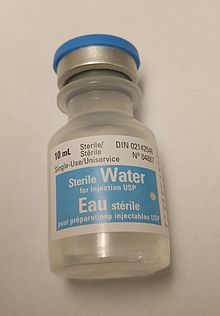Water for injection
 Sterile water for injection | |
| Clinical data | |
|---|---|
| AHFS/Drugs.com | FDA Professional Drug Information |
| License data | |
| ATC code | |
| Identifiers | |
| CAS Number | |
| ChemSpider | |
| UNII | |
| Chemical and physical data | |
| Formula | H2O |
Water for injection is water of extra high quality without significant contamination.[1] A sterile version is used for making solutions that will be given by injection.[2] Before such use other substances generally must be added to make the solution more or less isotonic.[3] It can be given by injection into a vein, muscle, or under the skin.[4] A non-sterile version may be used in manufacturing with sterilization occurring later in the production process.[5]
If it is given by injection into a vein without making it more or less isotonic, breakdown of red blood cells may occur.[3] This can then result in kidney problems.[3] Excessive amount may also result in fluid overload.[4] Water for injection is generally made by distillation or reverse osmosis.[5] It should contain less than a mg of elements other than water per 100 ml.[5] Versions with agents that stop bacterial growth are also available.[5]
It is on the World Health Organization's List of Essential Medicines.[6] Water for injection is available over the counter.[3]
Other names
Aqua ad iniectabilia or aqua ad injectionem
References
- ^ "<1232> Water for Pharmaceutical Purposes" (PDF). hmc.usp.org. p. 2. Archived (PDF) from the original on 11 March 2015. Retrieved 14 January 2017.
- ^ World Health Organization (2009). Stuart MC, Kouimtzi M, Hill SR (eds.). WHO Model Formulary 2008. World Health Organization. p. 493. hdl:10665/44053. ISBN 9789241547659.
- ^ a b c d "Sterile Water for Injection - FDA prescribing information, side effects and uses". www.drugs.com. Archived from the original on 18 January 2017. Retrieved 14 January 2017.
- ^ a b Lua error in Module:Citation/CS1/Date_validation at line 961: bad argument #3 to 'format' (string expected, got nil).
- ^ a b c d Ghosh, Tapash K.; Jasti, Bhaskara R. (2004). Theory and Practice of Contemporary Pharmaceutics. CRC Press. p. 396. ISBN 9780203644478. Archived from the original on 16 January 2017.
- ^ World Health Organization (2019). World Health Organization model list of essential medicines: 21st list 2019. Geneva: World Health Organization. hdl:10665/325771. WHO/MVP/EMP/IAU/2019.06. License: CC BY-NC-SA 3.0 IGO.
External links
- Inspection Technical Guides Water for Pharmaceutical Use
- Guideline on the quality of water for pharmaceutical use (EMA, European Medicines Agency)
- "Water for injection". Drug Information Portal. U.S. National Library of Medicine.
